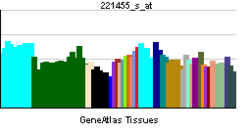WNT3
| View/Edit Human | View/Edit Mouse |
Proto-oncogene protein Wnt-3 is a protein that in humans is encoded by the WNT3 gene.[4][5]
The WNT gene family consists of structurally related genes that encode secreted signaling proteins. These proteins have been implicated in oncogenesis and in several developmental processes, including regulation of cell fate and patterning during embryogenesis. This gene is a member of the WNT gene family. It encodes a protein showing 98% amino acid identity to mouse Wnt3 protein, and 84% to human WNT3A protein, another WNT gene product. The mouse studies show the requirement of Wnt3 in primary axis formation in the mouse. Studies of the gene expression suggest that this gene may play a key role in some cases of human breast, rectal, lung, and gastric cancer through activation of the WNT-beta-catenin-TCF signaling pathway. This gene is clustered with WNT15, another family member, in the chromosome 17q21 region.[5]
References
- ↑ "Diseases that are genetically associated with WNT3 view/edit references on wikidata".
- ↑ "Human PubMed Reference:".
- ↑ "Mouse PubMed Reference:".
- ↑ Roelink H, Wang J, Black DM, Solomon E, Nusse R (Dec 1993). "Molecular cloning and chromosomal localization to 17q21 of the human WNT3 gene". Genomics. 17 (3): 790–2. doi:10.1006/geno.1993.1412. PMID 8244403.
- 1 2 "Entrez Gene: WNT3 wingless-type MMTV integration site family, member 3".
External links
Further reading
- Nusse R, Brown A, Papkoff J, et al. (1991). "A new nomenclature for int-1 and related genes: the Wnt gene family". Cell. 64 (2): 231. doi:10.1016/0092-8674(91)90633-A. PMID 1846319.
- Smolich BD, McMahon JA, McMahon AP, Papkoff J (1994). "Wnt family proteins are secreted and associated with the cell surface". Mol. Biol. Cell. 4 (12): 1267–75. doi:10.1091/mbc.4.12.1267. PMC 275763
 . PMID 8167409.
. PMID 8167409. - Liu P, Wakamiya M, Shea MJ, et al. (1999). "Requirement for Wnt3 in vertebrate axis formation". Nat. Genet. 22 (4): 361–5. doi:10.1038/11932. PMID 10431240.
- Gazit A, Yaniv A, Bafico A, et al. (1999). "Human frizzled 1 interacts with transforming Wnts to transduce a TCF dependent transcriptional response". Oncogene. 18 (44): 5959–66. doi:10.1038/sj.onc.1202985. PMID 10557084.
- Hartley JL, Temple GF, Brasch MA (2001). "DNA Cloning Using In Vitro Site-Specific Recombination". Genome Res. 10 (11): 1788–95. doi:10.1101/gr.143000. PMC 310948
 . PMID 11076863.
. PMID 11076863. - Katoh M (2002). "Molecular cloning and characterization of human WNT3". Int. J. Oncol. 19 (5): 977–82. doi:10.3892/ijo.19.5.977. PMID 11604997.
- Katoh M (2002). "Regulation of WNT3 and WNT3A mRNAs in human cancer cell lines NT2, MCF-7, and MKN45". Int. J. Oncol. 20 (2): 373–7. doi:10.3892/ijo.20.2.373. PMID 11788904.
- Strausberg RL, Feingold EA, Grouse LH, et al. (2003). "Generation and initial analysis of more than 15,000 full-length human and mouse cDNA sequences". Proc. Natl. Acad. Sci. U.S.A. 99 (26): 16899–903. doi:10.1073/pnas.242603899. PMC 139241
 . PMID 12477932.
. PMID 12477932. - Niemann S, Zhao C, Pascu F, et al. (2004). "Homozygous WNT3 Mutation Causes Tetra-Amelia in a Large Consanguineous Family". Am. J. Hum. Genet. 74 (3): 558–63. doi:10.1086/382196. PMC 1182269
 . PMID 14872406.
. PMID 14872406. - Gerhard DS, Wagner L, Feingold EA, et al. (2004). "The Status, Quality, and Expansion of the NIH Full-Length cDNA Project: The Mammalian Gene Collection (MGC)". Genome Res. 14 (10B): 2121–7. doi:10.1101/gr.2596504. PMC 528928
 . PMID 15489334.
. PMID 15489334. - Chiba H, Kobune M, Kato J, et al. (2005). "Wnt3 modulates the characteristics and cobblestone area-supporting activity of human stromal cells". Exp. Hematol. 32 (12): 1194–203. doi:10.1016/j.exphem.2004.08.010. PMID 15588944.
- Yamamoto H, Komekado H, Kikuchi A (2006). "Caveolin is necessary for Wnt-3a-dependent internalization of LRP6 and accumulation of beta-catenin". Dev. Cell. 11 (2): 213–23. doi:10.1016/j.devcel.2006.07.003. PMID 16890161.

